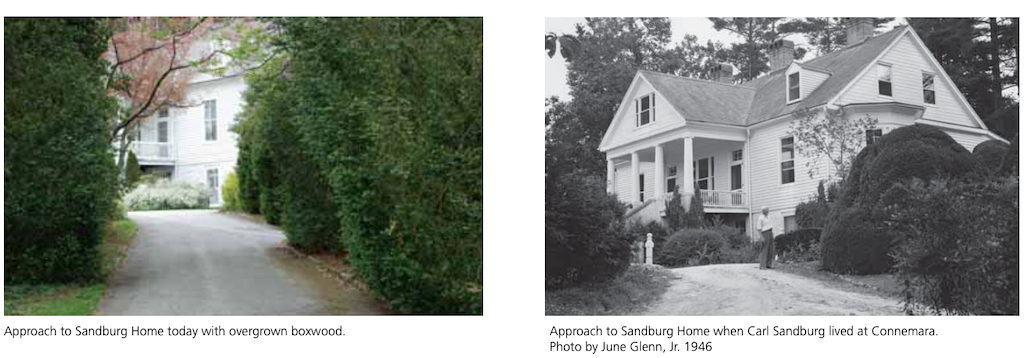
A boxwood shrub has lost almost all its leaves due to blight/NPS
A focal point of the Carl Sandburg Home National Historic Site in North Carolina is being cut down because of a deadly disease.
Park staff say "boxwood blight" has been discovered in some of the 150-year-old boxwood shrubs at the property. Staff began removal of the affected boxwoods on March 19. They wore protective clothing and the vegetation was bagged and removed to prevent spread of the blight to other boxwoods.
According to the park, "(T)he boxwood at Carl Sandburg Home are a focal point in the landscape. They line the drive across from the barn, and the approach to the Sandburg house."
While there are about 70 species and many varieties of boxwood, at the Sandburg Home the species are American boxwood (Buxus sempervirens), English boxwood (Buxus sempervirens ‘suffruticosa’), and Korean boxwood (Buxus microphylla). The park release did not say how many boxwoods were to be cut down.

This undated file photo shows the boxwoods that line the home's driveway/NPS file
According to the park, healthy boxwoods can live for hundreds of years.
The North Carolina Cooperative Extension office has helpful information for visitors and homeowners about boxwood blight. Boxwood blight is a disease caused by a fungus and was first diagnosed in North Carolina in 2011. It has been reported in 27 other states. There is no cure, so infected plants should be removed from the landscape to prevent further spread of this contagious disease. Common symptoms of boxwood blight are brown leaf spots that lead to dieback of branches and eventually the entire plant. After dying, the leaves will fall off the stems. Black streaking is sometimes visible on the stems.
Boxwood blight fungus can spread on pruning tools, clothing, equipment, or other items that come into contact with infected plants. If you come into contact with an infected plant, be sure to sanitize your tools, clothing and shoes. A solution of 9 parts water to 1 part bleach is effective for tools. Clothing can be laundered as normal. Although park staff doesn't know how these boxwoods were initially infected, they ask visitors to help save the remaining historic boxwoods and help prevent the spread of blight to their own neighborhoods by staying on trails and limiting human and pet contact with these plants.
More information about the blight can be found at https://forsyth.ces.ncsu.edu/2019/08/boxwood-blight-info.

 Support Essential Coverage of Essential Places
Support Essential Coverage of Essential Places







Comments
Does the fungus come to the Boxwood like cat feet?